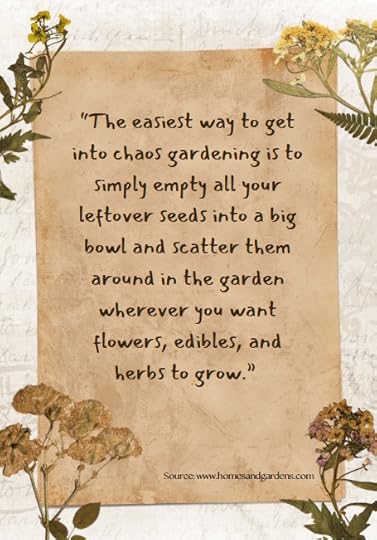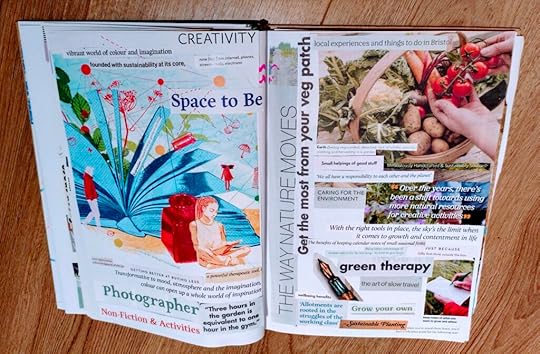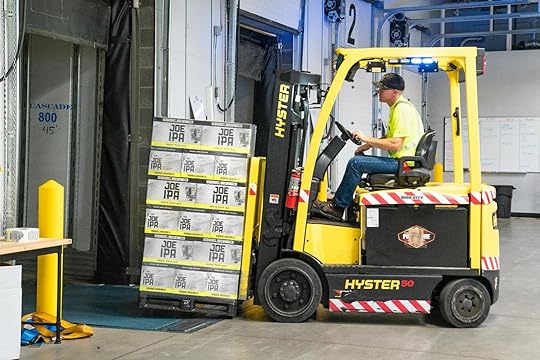Amy C. Fitzjohn's Blog
November 21, 2025
Launching Hen’s Tooth: The Story Behind My New Online Shop
It’s been a while since I last updated this blog, and for good reason. Over the past months, I’ve been pouring my energy into something new, exciting, and a little daunting: the launch of Hen’s Tooth, my online shop dedicated to slow living, unique gifts, handmade treasures, and nature inspired rare finds, all curated with care.
Regular readers will remember that I finally got my hands on an allotment after being on the waiting list for 6 years! I named the allotment – Hen’s Tooth – because it was such a rare and precious thing.
The idea for my online shop sprang from this: “what if I could creature an income selling lively things online so I can hang out at my allotment whenever I like” – it had to call it Hen’s Tooth!
 Hen’s Tooth – Rare finds, curated with care.A Story of Ups and Downs
Hen’s Tooth – Rare finds, curated with care.A Story of Ups and Downs Starting an online shop has been a journey filled with ups and downs, lessons learned, and moments of pure joy. Here is the story so far behind Hen’s Tooth – from the challenges of unreliable suppliers to the thrill of welcoming my very first customer.
The Early Struggles: Dodgy Suppliers and DelaysLike many small business owners, I began with big dreams and a notebook full of ideas. But reality hit quickly. Some of my first suppliers didn’t live up to expectations. From sample orders taking nearly a month to arrive, to poor quality items and even a very ugly tablecloth that bore no resemblance to the one I ordered – at least I got a refund!
Another drop shipping platform listed a company that turned out to have gone bust 3 months ago. Luckily, I got a refund for that one as well!
I’ve since found 2 really good and reliable UK based suppliers – however, they don’t ship overseas so for now, it will limit my options on some of my product listings.
It was frustrating, and at times I wondered if I’d made a mistake. But every setback taught me something valuable: the importance of trustworthy partnerships and the need to stay true to my vision of offering customers items that are both beautiful and dependable.
Turning the Corner: Finding Better SuppliersAfter those rocky beginnings, I made the decision to re-evaluate my supplier list. I spent weeks researching, testing, and reaching out to new partners. This time, I focused on suppliers who:
Offered higher quality products that matched my brand’s values.Provided faster, more reliable shipping — essential for seasonal gifting.Shared my commitment to authentic craftsmanship and sustainability.The difference was night and day. Suddenly, I had access to items I was proud to showcase — from handmade wooden Christmas decorations to vibrant velvet journals for stationery lovers.
 Vibrant journals from Hen’s ToothThe High of the First Customer
Vibrant journals from Hen’s ToothThe High of the First CustomerNothing compares to the moment when Hen’s Tooth welcomed its very first customer. Seeing that order come through was a mix of relief, excitement, and gratitude. It wasn’t just about the sale — it was proof that someone believed in what I was building.
That first customer reminded me why I started this journey: to create a shop that celebrates thoughtful gifting, slow living, and items with real character.
Building the Collection: From Décor to JournalsSince launch, I’ve been curating collections that blend utility, style, and emotional resonance. Highlights include:
 Handcrafted Wooden Christmas Decorations
– each piece unique, thanks to natural wood grain variations.
Handcrafted Wooden Christmas Decorations
– each piece unique, thanks to natural wood grain variations. Velvet & Leather Journals
– perfect for those who love notebooks, journaling, and stationery.
Velvet & Leather Journals
– perfect for those who love notebooks, journaling, and stationery. Festive Gifts for Him – practical yet stylish items designed to make Christmas shopping easier.
Festive Gifts for Him – practical yet stylish items designed to make Christmas shopping easier.Every product tells a story – chosen with care, ensuring it’s something I’d be proud to give or receive myself.
It’s also given me the perfect excuse to switch up some of my own home decor – strictly in the name of product testing of course!
 Gorgeous tufted cushions for my own sofa!Why I’ve Been Quiet on the Blog
Gorgeous tufted cushions for my own sofa!Why I’ve Been Quiet on the BlogI owe you an apology for not updating this blog sooner. The truth is, launching Hen’s Tooth has taken every ounce of focus and energy. Between sourcing suppliers, designing product categories, and preparing for Christmas gifting, time has flown by.
I’m excited to share more stories, updates, and behind-the-scenes insights as Hen’s Tooth continues to grow.
Looking Ahead: A Shop Built on Trust and JoyHen’s Tooth isn’t just about selling products — it’s about creating a space where gifting and furnishing a cosy home, feels authentic, joyful, and stress-free. I want customers to feel confident that every item has been carefully selected, tested, and chosen with love.
Call to Action: Be Part of the StoryAs Christmas approaches, I’d love for you to be part of Hen’s Tooth’s journey.
 Visit the site
and explore the shelves.
Visit the site
and explore the shelves. Add your favourites to your wish list
— especially as items are selling fast.
Add your favourites to your wish list
— especially as items are selling fast. Sign up to the VIP newsletter
for early access to new arrivals, exclusive offers, and festive inspiration.
Sign up to the VIP newsletter
for early access to new arrivals, exclusive offers, and festive inspiration.Your support means the world, and together we can make this season one of warmth, generosity, and meaningful gifting.
Final ThoughtsLaunching Hen’s Tooth has been a rollercoaster — from dodgy suppliers to the joy of the first customer, from sleepless nights to the excitement of curating new collections. But every step has been worth it.
The story of this shop goes beyond a business; it’s a celebration of craftsmanship, tradition, and thoughtful gifting. And I can’t wait to see where the journey takes us next.
 Ready to discover Hen’s Tooth? Visit the shop today — browse the shelves, add your favourites to your wish list, and sign up to the VIP newsletter for festive updates.
Ready to discover Hen’s Tooth? Visit the shop today — browse the shelves, add your favourites to your wish list, and sign up to the VIP newsletter for festive updates.
The post Launching Hen’s Tooth: The Story Behind My New Online Shop appeared first on Amy Morse.
March 31, 2025
Reasons to Get Journaling
A regular journaling habit can be a great resource for writers, bloggers, creatives, and entrepreneurs – but more than that, it’s easy to overlook the benefits to our mental health of decluttering our brain.
Here is a snapshot of just a few of the benefits of nurturing a regular journaling habit:
Mental & Emotional Well-being Reduces stress – Writing out your thoughts helps clear your mind.
Reduces stress – Writing out your thoughts helps clear your mind. Improves self-awareness – Helps you understand your emotions and patterns.
Improves self-awareness – Helps you understand your emotions and patterns. Boosts mindfulness – Encourages you to live in the present.
Boosts mindfulness – Encourages you to live in the present.
🩵 Helps process emotions – Writing through tough times can be therapeutic.
 Clarifies goals – Putting them on paper makes them feel real.
Clarifies goals – Putting them on paper makes them feel real. Tracks progress – See how far you’ve come over time.
Tracks progress – See how far you’ve come over time. Boosts creativity – Writing freely can spark new ideas.
Boosts creativity – Writing freely can spark new ideas. Improves decision-making – Organising thoughts makes choices clearer.
Improves decision-making – Organising thoughts makes choices clearer.
 Enhances memory – Writing things down helps you retain information.
Enhances memory – Writing things down helps you retain information. Connects ideas – Helps you see patterns and insights you might miss otherwise.
Connects ideas – Helps you see patterns and insights you might miss otherwise. Encourages reflection – Looking back helps you learn from experiences.
Encourages reflection – Looking back helps you learn from experiences.
 Improves sleep – Writing before bed can ease anxiety.
Improves sleep – Writing before bed can ease anxiety. Supports mental health – Helps manage anxiety, depression, and stress.
Supports mental health – Helps manage anxiety, depression, and stress. Boosts positivity – Gratitude journaling increases happiness.
Boosts positivity – Gratitude journaling increases happiness.
Have you ever bought a lovely notebook then not wanted to ‘ruin it’ by writing in it?
Have you felt crippled into inaction when faced with a blank page?
The pressure to write something down only fuels the anxiety you were hoping to tame by journaling!
That’s where a guided journal can help.So I created one! (well, the same one but with different covers!) Guided journal out now on Amazon
Guided journal out now on AmazonIt’s out now on…
 What’s Inside?
What’s Inside?The theme is self reflection.
Here are some examples of what it looks like inside.
 A lined page, with space to free write
A lined page, with space to free writeIt includes thought-provoking journal prompts:
 Example prompt page
Example prompt pageSome pages are set out as a list, sometimes your journaling might just be thinking of things you want to get done.

 Here are the other cover options
Here are the other cover options
The post Reasons to Get Journaling appeared first on Amy Morse.
March 27, 2025
The Oxymoron of Chaos Gardening
An oxymoron is a literary device that uses two opposing or contradictory words to convey a new idea. Examples of oxymorons include: Old news. Painfully beautiful or Chaos gardening…
Bare with me on this one…Surely a garden is a managed space? Which is the opposite of chaos?
The act of ‘gardening’ involves human intervention. Even if your garden is stylized to be wild, there is still a certain amount of carefully curating the planting, cultivating, pruning, tidying up, and general tinkering to have the garden you want.
The trend for rewildingRewilding focuses on restoring natural ecosystems by allowing nature to regenerate with minimal human intervention. It’s increasingly popular as it’s a easy win to restore biodiversity and to make a positive impact on the environment.
In urban, gardens are the closest thing to a natural environment and contribute significantly to biodiversity. Our gardens and parks are the green lungs of our cities.
Yet the very act of gardening is about a managed natural space – bringing some order to chaos such as; neat rows of veg, herbaceous borders, artfully clipped topiary or impeccably striped lawns.
Even a rewilded space requires a certain amount of management to ensure that invasive species are kept in check and to maintain a variety of habitats for different species.
A fine example of rewilding on a grand scale is the Knepp Estate in southern England. It’s 20 year project to rewild 3,500-acres of British countryside not only benefits biodiversity, but it is also a business success story.
So the notion of a chaos garden is, in my view, a balance between a rewilded space and a fastidiously kept garden.
I love the idea of a chaos garden as it speaks to the way my brain works – carefully curated chaos!Whether I like it or not, Hen’s Tooth wants to revert to some semblance of the mixed grassland habitat that it was before the city of Bristol extended its limits into the Somerset countryside, absorbing whole towns into it’s sphere that have now become districts of the city – like my home district of Bedminster and the neighbouring Bedminster Down district where Hen’s Tooth is.
Chaos Gardening Mixed PlantingI have native wildflowers springing up such as speedwell, teasels, red and white deadnettle, clover, common vetch, agrimony, comfrey, rosebay willowherb… all lovely things that benefit biodiversity and I wouldn’t want to eliminate. On the other hand, left unchecked, they can take over.
Instead of concerning myself with immaculate rows of veg, I want to go for a mixed habitat, more of a cottage garden feel with herbs and flowers interspersed with fruit and veg.
I’m inspired by this article by Homes and Gardens that recommends the best plants to choose for chaos gardening:


To keep track of my successes and failures, I’ll be using my Allotment Journal
It’s available on Amazon in two different cover designs.

Perfect for recording thoughts, ideas, and observations to be mindfully in tune with your allotment.

The post The Oxymoron of Chaos Gardening appeared first on Amy Morse.
March 5, 2025
Important Factors That Will Impact International Expansion Efforts
If you are considering taking your small business international, these contributor tips will help.
Important Factors That Will Impact International Expansion EffortsPreparing to scale your business to offer your services or deliver products internationally is a testament to your business’s potential for growth and expansion. It’s an exciting opportunity to tap into a new market for your company. However, it’s important to remember that success in your primary country of operation doesn’t guarantee automatic success in a new country.
Let’s take a look at some important considerations prior to offering international shipping and services.
DemandFirst, you need to ascertain if there is a demand. You can do this via extensive market research, identifying who your competitors would be and what sales look like for what you do. Different countries have different needs and customs you should be aware of that can impact your visibility in a new market.
Registrations and ComplianceYou don’t need to be registered in all countries you are exporting to, but it’s important that you understand if you need to be tax registered, for example, or if you need to meet certain regulations to be able to sell your products. It is important you take the time to understand the implications for your business to ensure you are trading legally and you aren’t letting people down by them not being able to receive products or purchasing illegal services due to your non-compliance or naivety.
ShippingShipping will be different from country to country, and each one will have rules and regulations in relation to VAT and tax that can impact your ability to ship to that country and what you can charge. For example, shipping to the EU can be complex for small businesses, especially since the changes in VAT rules can increase costs to the customer. While options like DDP – delivery duty paid can reduce the cost to the consumer as the business absorbs it, in some countries, deliveries made this way can be refused. So, it’s important to know what your legal obligations are both in your resident country and the countries you will be shipping to.
Market Entry StrategyEvery business expanding internationally needs a well-thought-out market entry strategy. This strategy details how you will introduce your solution to the market and what activities you will undertake to ensure success. Whether it’s through franchising, setting up a subsidiary, forming partnerships, or direct sales, having a clear strategy will help you navigate the complexities of international expansion.
Cultural UnderstandingUnderstanding cultural differences is crucial. It’s not just about being aware of what is and is not acceptable for the offerings you will have available. It’s also about respecting and understanding the social and cultural norms of the countries you will be operating in. It’s employee culture, workplace ethics, legal obligations pertaining to employees, trading hours, restrictions on activities, and so much more. Neglecting to do so can lead to unintended offence or even legal issues.
International expansion can be an amazing way to promote your business to new heights, but if you approach it carefully, it can also spell disaster for you, too.
The post Important Factors That Will Impact International Expansion Efforts appeared first on Amy Morse.
February 12, 2025
The Principles of Permaculture and Why They Are Important
Sustainable living and conscious consumption are increasingly part of the global conversation, but for those with no involvement in agriculture or growing your own food, permaculture may not be quite so familiar.

Permaculture is a well established philosophy that harnesses nature’s own resilience to create self-sustaining ecosystems. It’s not about ‘protecting the environment’ it’s about actively embracing natural cycles, and processes of regeneration and restoration.
The aim of permaculture is to create a future where human activities enhance rather than deplete our environment. It’s living a better life, in a more wholistic way.
What Does It Mean For Your Own Allotment or GardenMy motivations for having an allotment are rooted in my core values of wanting to live more sustainably and self sufficiently. I wanted to get outdoors more, work with and in nature, and create abundant healthy, seasonal, organic food.
It’s good for my mind, body and soul.
As another growing season starts, I’m learning more and more about some of these guiding principles and their wider impact, beyond my little slice of land I call Hen’s Tooth.
 The Principles of PermacultureObserve and Interact
The Principles of PermacultureObserve and InteractIt starts with taking the time to observe natural systems before making changes. When it comes to growing your own produce, this could include mapping the route of the sun across your plot through the year. Where are the shady areas? How does that change over the course of the year? Where are the dry or windy areas of your plot? What is the composition of your soil – is it sandy, chalky, heavy clay, or a combination? Then taking steps to make the most of and improve what we already have.
Catch and Store EnergyThe use of resources needs to be cyclical. Nothing is wasted. This could include having systems in place to catch and store water and creating your own compost with waste materials. On a bigger scale it could be harvesting energy through solar panels etc. By storing these energies, you can make them available when needed.
Abundant YieldsFor our efforts to be worthwhile, we need to enjoy their tangible benefits. Whether that’s an abundant supply of fresh, seasonal, organic food, or energy and other resources.
Self-Regulate and Get FeedbackNature has built-in feedback mechanisms. By applying self-regulation; what went well, what didn’t go so well, and what did we learn – and being open to feedback, we can adapt to enhance sustainability and productivity.
Use and Value Renewable Resources and ServicesThe whole point of permaculture is about give and take, not just take. The emphasis will always be on the use of renewable resources and reducing our dependence on non-renewable ones. This principle encourages us to make the best use of nature’s abundance and minimise waste.
Produce No WasteIn nature, there is no concept of waste; everything is recycled. Permaculture strives to mimic this by ensuring that outputs from one system become inputs for another.
Design from Patterns to DetailsBy acknowledging and working with natural patterns, we can create designs that work more efficiently. This principle encourages us to look at the big picture first and then refine the details.
Integrate Rather than SegregateEmbrace a messy garden. Interactions between components of a system often provide more benefits than the individual components themselves. Integrating plants, animals, and people in a way that they support each other leads to more resilient and productive ecosystems. Encourage beneficial biodiversity to your land and focus on the health of your soil. Healthy soil, nurtures healthy plants.
Use Small and Slow SolutionsLarge, fast changes often lead to problems. One step at a time, don’t try to do too much all at once. Small, incremental changes allow for learning and adaptation over time.
Use and Value DiversityDiversity reduces vulnerability to a variety of threats and encourages resilience. There will always be successes and failures, but when you grow a variety of produce, you will always have something in abundance.
Use Edges and Value the MarginalThe interface between different elements is where the most interesting and productive things happen. By valuing these edges, we can maximise productivity.
Creatively Use and Respond to ChangeChange is inevitable, but by being flexible and innovative, we can turn challenges into opportunities.
Why These Principles Are ImportantBuilding community, making the best of the resources available without taking things for granted, or generating unnecessary waste, creating abundance, and enhancing resilience, these are the principles of permaculture that light the way to a more sustainable and equitable future.
The post The Principles of Permaculture and Why They Are Important appeared first on Amy Morse.
January 30, 2025
Reducing Inefficiency From Logistics: 5 Strategies for Success
Scaling a business can have unforeseen challenges for your logistics.
Here are 5 tips from a contributor.
Logistics is one of the many different challenges businesses face when scaling their eCommerce enterprise. With tasks including handling, delivery coordination, inventory checks, and more, the process of filling and shipping the order to a customer requires multiple steps to reach its conclusion.
If you mishandle any of the steps or your process isn’t as smooth as it should be, then now is the time to change it.
Optimising your logistics means simplifying everything to deliver the best results, and these strategies can enable you to do just that.
Use 3PL3PL providers, or third-party logistic providers, are like a breath of fresh air for your business. They handle the entire shipping process for you. All you need to do is send them your inventory, and they take care of the storage, packing, and shipping. This liberates you from the complexities of logistics, allowing you to concentrate on other vital areas of your business.
Fulfillment services can offer a range of benefits for both the business and the customer, including real-time tracking, inventory management, and automated systems, and are easily scalable so you can handle increased demands and changes in order frequencies and volumes with ease.
Understanding what to expect when finding the perfect 3PL company to partner with is empowering. It ensures you know what to expect upfront and can guarantee they provide a service that meets the expectations of your customers. This knowledge puts you in the driver’s seat, giving you the confidence to manage your logistics effectively.
Streamline The Supply ChainBuilding strong relationships with vendors is crucial for streamlining your supply chain. It ensures you can get what you need when you need it and that the delivery and order process works for you as the business needs it. This sense of security and control is vital because having adequate stock levels is part of the battle for improved logistics.
The better your communication with vendors, the easier it will be to handle delays, shortages, discontinued line changes in manufacturers, etc. Your aim should be to reduce lead times, have a good, reliable supply of what you need, and be able to track everything to improve accuracy, efficiency, and more.
Invest in TechnologyTechnology is key for anything and everything within a business capacity, and neglecting to utilise tech to improve processes will hinder your ability to make beneficial changes to what you do across the board. But especially for logistics.
For instance, inventory management software can help you keep track of your stock levels, route optimisation software can help you plan the most efficient delivery routes, and order tracking platforms can provide real-time updates on the status of your orders. These technologies can help you reduce errors and make more accurate plans based on the information you have on hand. Other useful technologies include warehouse management systems, transportation management systems, and barcode scanning tools.
You don’t even need a massive budget to integrate technology to boost your fulfillment operations; you can use cloud-based services to get what you need and benefit from what is available without high upfront costs.
Optimise ShippingShipping can be expensive. There is no getting around that, but there are things you can do to help you keep costs down and make them manageable for you as a company and for the customer, too.
Comparing rates for different carriers, changing how you package items, offering different types of shipping to vary costs, switching to lightweight packing solutions and removing any excess from the packaging can enable you to keep costs lower so you’re not spending too much.
For instance, you can offer free shipping for orders over a certain amount or provide discounted shipping rates for slower delivery options. This can give your customers more control over their shipping costs and make your products more attractive.
Focus on Inventory ManagementInventory management is instrumental in smothering logistics. There are ways in which you can enhance inventory management to ensure your fulfilment services are running as efficiently as possible.
JIT Model – the JIT model is the Just in Time approach, and it ensures that you have what you need when you need it, so you’re not wasting time, money, and resources holding stock you don’t need.Audits – regular audits can allow you to spot bottlenecks and address inefficiencies, and you can use this data to make smarter, more efficient purchasing decisions.Automation – automation tools can be integrated into your sales platforms to ensure accuracy. This allows you to have a more agile reactive response to issues so you can keep on top of problems or preempt them altogether.The post Reducing Inefficiency From Logistics: 5 Strategies for Success appeared first on Amy Morse.
December 16, 2024
Are Self-Employment Transport Costs Driving You Around The Bend?
Even when we are self employed and work from home much of the time, there will always be occasions when we need to travel for our business. From a sustainability point of view, if there is a sensible way to get somewhere via public transport, that should always be the first choice, but sometimes i’t not practical or affordable. This contributor shares some tips about how to manage the transport costs in your business.
Transport costsThe perks of self-employment are undeniable. Whether you write books, have a blog, or offer services like copywriting to clients, the chances are that you’re happier now than you ever were in employment.
However, whether you’re new to the freelance world or have been doing this dance for a few years now, one thing never gets easy – the financial burden. Sure, it’s nice not having a boss breathing down your neck, but that also means there’s no shiny holiday pay and no paid sick leave. There’s also no company car waiting for you. Yet, with public transport becoming increasingly unreliable, you still need to fork out on your own transport to arrive at all your meetings on time.
This vehicle cost, alone, could be enough to send you around the bend. There’s a real risk that it’ll also outstrip the value of your solo business pursuits unless you take the following steps to reduce that financial hit.

# 1 – Know What You Can Claim
Claiming expenses is the self-employed alternative to workplace benefits, and ensures you can significantly offset your tax bill at the end of the year. In a roundabout way, that’ll save you a lot of money across even a few short years of freelancing.
Luckily, if you’re using your car for even occasional business meetings, it very much falls under your claimable allowance. Travel expenses include fuel, servicing, and vehicle insurance. You can also claim tax relief travelling to a from a temporary workplace such as a coworking space if you spend less than 40% of your working time there.
# 2 – Have Money in the Bank
When you are your business, sudden car failures can come at a steep cost. As such, it’s always worth having a vehicle fund within your savings somewhere.
This is easier said than done, of course, but there are ways to set money aside. For instance, you could save your vehicle-based tax relief for this purpose. Alternatively, if you finance your business vehicle, you may be able to claim some money back for things like mis-sold policies. BMW, Mercedes, and Volkswagen PCP claims have all led to payouts on professional vehicles and could see you claiming back thousands to put in the bank for car costs moving forward.
# 3 – Avoid Major Disruptions
Being able to afford vehicle repairs and maintenance is one thing, but your business also relies on your ability to avoid major disruptions that could cost clients and, ultimately, money.
One simple option is to keep on top of annual car servicing and general maintenance checks. If you do most of your work at home, it’s also worth starting up your car at least once a week and taking it for a short drive. This way, you reduce the risks of expensive delays like a seized-up engine.
Freelancers need to get from A to B to succeed, but don’t let transport costs drive you around the bend. Instead, stay on the straight and narrow with these tips!
The post Are Self-Employment Transport Costs Driving You Around The Bend? appeared first on Amy Morse.
December 6, 2024
Craft Your Vision Board for the Year Ahead
As the Earth completes another orbit of the Sun, we naturally look ahead. Preferably with hope and optimism – although that can be challenging in these trying times.
It’s always around his time of year (December / January) that I like to create a vision board (or two).
Holding space to take a beat, reflect on the year that has almost ended and what I want from the year ahead.
On this day next year, what do I want to be able to say I have achieved.
What is a Vision BoardA vision board is a creative tool used to help clarify, focus, maintain motivation, and set your intentions – in this case, for the year ahead.
It’s essentially a visual representation of your dreams, desires, and aspirations, created by assembling images, words, and other elements that inspire you.
But it’s not just something you do to visualise your New Year’s Resolutions, you can do them at any time or for many reasons.
I like to create full page spreads in my journals, but you can also create them on a large piece of paper or card and display them somewhere prominent to motivate and inspire you.

I have them in my journal, which I use as my ‘day book’ so I can flick back and look at them regularly.
I also played with Word Clouds, taking words from my vision board and putting them into WordArt online word cloud platform.
 Features of a Vision BoardVisual Focus
Features of a Vision BoardVisual FocusFill it with images, phrases, or objects that symbolise your goals, intentions, to set the tone, or the feelings you want to evoke.
PersonalisationEach vision board is unique and reflects the creator’s personal aspirations, whether related to career, relationships, health, travel, or personal growth.
Physical or DigitalVision boards can be made on paper or card, or digitally using tools like Canva or Pinterest.
Personally, I believe they should be done physically by finding images and words and cutting them up. The physical act is one of play and creativity which activates different areas of the brain. Plus, any activity that takes us away from screens for a while has multiple benefits for our wellbeing.
You can always make them digital afterwards.
Benefits of Vision BoardsClarity: define what you want and what is important to you
Permission: giving yourself permission to daydream and play for a while does wonders for your mental health.
Motivation: Seeing your aspirations displayed can be a daily reminder to take action
Manifestation: It’s often associated with the idea of the law of attraction, which suggests that focusing on your goals helps bring them to reality.
Joy of play: It’s just fun to cut up pictures and words and turn them into something visually engaging
Top Tips to Create Vision BoardsKeep a stock of old magazines so you always have resources to draw fromKeep any words or scraps that resonate but don’t fit on your board, you can always use them as journal prompts or on future vision boardsCollect stickers and washi tape – these are quick and easy ephemera to add aesthetic to your vision board. Washi tape is also useful to divide your board upHave an ‘art box’ with glue, scissors scraps How to Make a Vision Board:Set Intentions: Reflect on what you want to achieve in the near or long-term future. Where do you want to be this time next year?Gather Materials: Collect magazines, printouts, photos, quotes, and other inspiring items. I always keep a stock of old magazines and add to it regularly so I have plenty of resources to draw from. I have also run Vision Board workshops for groups of entrepreneurs, which gives me the perfect excuse to hoard pretty things for ‘work’.Curate: Once you’ve gathered a pile of scraps, you must choose what to use, how to use it and what to discard. This sifting process forces you to make decisions and focus on the key elements and aestheticsCreate: Arrange and glue these items onto your board in a way that resonates with you.Display: Place your vision board somewhere visible to remind you of your goals daily.Having a Vision BoardWhat’s the point?Firstly, there is great value on looking back and celebrating past achievements, but equally, if we take time to think about stepping into the future with intention we can focus our energy on moving forward in a positive direction that we want to take, instead of drifting along on the treadmill simply existing.
I republished an old blog on Vision and Vanity HERE to inspire me.
Vision Boards are More than ManifestingA vision board is more than just a collection of inspiring images, words, and ideas pasted onto a piece of paper.
Visualisation is more than manifesting. It’s about imagining yourself doing or being something, but I’m not vain enough to think that by just imagine something it will come true. This is about setting intentions and having something to focus on. By crafting a vision board, you create a tangible representation of your goals, passions, and aspirations, helping you align your daily actions with your long-term vision. You can then build your goals, plans and plot your steps to make it happen.
1. Clarifies Your GoalsThe process of creating a vision board forces you to articulate your dreams and desires. Instead of vague aspirations like “I want to be successful,” you’ll identify specific, meaningful goals—whether it’s owning a cozy home, starting a creative business, or traveling to your dream destinations. This clarity provides a clear direction for your energy and efforts.
2. Boosts Motivation and FocusPlacing your vision board somewhere you’ll see it regularly serves as a constant reminder of what you’re working towards. The visual and emotional connection to your goals helps you stay motivated, even when challenges arise. Seeing your dreams represented in vivid colors and imagery keeps you focused on the bigger picture.
3. Activates the Law of AttractionVision boards are rooted in the principles of visualisation and the law of attraction. By imagining yourself living the life you desire, you send positive energy into the universe and set the stage for manifesting those dreams. This practice encourages you to think and act as if your goals are already achievable, fostering a mindset of success. If you can imagine yourself doing something or being somewhere, you are more likely to make it happen
4. Encourages Creativity and Self-ExpressionDesigning a vision board is an inherently creative activity. When you’re cutting out magazine clippings or arranging photographs, you’re using art to express your aspirations. This creative process not only makes the activity enjoyable but also helps you tap into your intuition and inner desires.
Even if you don’t think of yourself as ‘creative’, you can still express yourself without the pressure of perfection or needing artistic skills.
5. Provides Emotional and Mental ClarityLife can feel overwhelming with competing priorities and distractions. A vision board acts as a grounding tool, allowing you to step back and reflect on what truly matters. By narrowing your focus, you gain emotional clarity and reduce feelings of stress or indecision.
6. Builds AccountabilityWhen your goals are visually displayed, you’re more likely to take actionable steps toward achieving them. A vision board acts as a form of self-accountability—it’s a daily nudge to work toward your dreams. It also makes it easier to share your goals with others, creating opportunities for collaboration and support.
7. Fosters Positive MindsetA vision board is a celebration of possibilities and positivity. It encourages you to think optimistically and believe in your potential. This shift in perspective can improve your overall mental health, as focusing on positive outcomes reduces anxiety and builds confidence.
8. Tracks Your GrowthAs time passes, you may realise you’ve achieved many of the items on your vision board. This serves as a reminder of your progress and growth. Revisiting and updating your board allows you to reflect on how your goals and priorities evolve, giving you a renewed sense of purpose.
Final ThoughtsCreating a vision board isn’t just an artistic exercise—it’s an empowering ritual that can transform your mindset and your life. It allows you to dream big while staying grounded in what you truly value. Whether you’re just starting your journey or looking to reimagine your future, a vision board is the perfect way to harness the power of visualisation and step confidently toward your goals.
So, grab some scissors, glue, and a pile of magazines and start crafting your future today!
The post Craft Your Vision Board for the Year Ahead appeared first on Amy Morse.
July 8, 2024
7 Product Marketing Mistakes To Avoid
It’s easy to make mistakes when marketing your business. Here are 7 top tips from a contributor.

Pexels. CCO Licensed.
Getting people to buy your product requires marketing. But not just any type of promo will do. With so many products constantly being advertised to us, it’s important that you find a way to cut through the noise while also keeping up with the marketing standards of other companies. There are lots of mistakes that you can make that can result in you failing to grab people’s attention or failing to gain their trust. Below are 7 examples of mistakes that you should try to avoid when marketing your product.
Inconsistent branding
Every successful product needs a strong brand. This should include a memorable brand name, a striking logo, a fitting colour scheme and an engaging tone of voice. Once you’ve established a brand, it’s important to apply the same branding to every marketing channel. Using different logos or colour schemes can create confusion and make consumers doubt whether they’re dealing with the same product. Such branding consistencies are most common when rebranding your product – make sure that your brand is updated everywhere so that you’re not continuing to promote an old brand.
Bland packaging
Snazzy packaging will help your product to stand out on the shelf. Use a custom packaging manufacturer to create something that’s relevant to your brand but different to competitors. To make sure your packaging stands out, it could be important to research other brands out there that are similar to your product. Think about the colour, the shape, the fonts, the imagery and opening mechanism and make sure one of these elements is unique.
Poorly targeted ads
Knowing your target audience is essential to making sure that you target your ads correctly. You don’t want to be wasting money targeting ads at people who aren’t going to pay attention. If you’re not sure who your target market is, consider doing surveys and take time to analyse the market of your competitors.
Irrelevant sponsorship
This is similar to poorly targeted advertising, but refers purely to using influencers. Paying influencers such as bloggers, vloggers and social media personalities to promote your product is a great way to raise awareness of your product. However, it’s essential that you work with sponsors who share the same audience as you. Consider influencers that cater to niche interests and passions related to your product for the best impact.
Amateurish web design
Poor quality product photos, poorly written product descriptions, slow loading pages and confusing website navigation can all put customers off. Spend time researching other websites and try to match their quality. Hiring the help of professionals including product photographers, copywriters and web designers could be worthwhile.
Lack of SEO
Not everyone is susceptible to outbound marketing tactics like adverts. In fact, many consumers are able to tune out adverts and purely buy products that they have searched for based on their needs. If you want these consumers to discover your product, you need to make sure that your product is displaying on search engines when relevant search terms are entered. This requires SEO (search engine optimization). This is a complex form of marketing that involves understanding search engine algorithms. It is best to work with an SEO company to handle this form of marketing for you and get results.
No USP
A USP (Unique Selling Proposition) is the thing that makes your product stand out. Without a USP, no-one will notice your product. Therefore, you need to work out what is special about your product. Once you’ve determined this, make sure that your USP is integrated into your marketing.
The post 7 Product Marketing Mistakes To Avoid appeared first on Amy Morse.
May 21, 2024
Here’s How To Ensure Your Business Appeals To Modern Customers
The needs of your customers are constantly changing and businesses that don’t respond will be left behind.
Top tips here from a contributor to appeal to modern customers.Are you eager to ensure that your business appeals to modern customers? If so, then you might need to make a few alterations to your business model. Here are some of the key possibilities that are worth exploring.
 Remain Sustainable
Remain Sustainable First, you need to make sure that you are focusing on high levels of sustainability. customers these days are often highly eco-conscious and eager to buy from businesses that are matching the right green goals. There are lots of ways to show customers that your business is green-friendly. For instance, you might want to think about focusing on your packaging. Green packaging is readily available in a variety of different forms for countless products. As such, it’s just a matter of finding the right option for your business.
Think About Design ChoicesNext, you should think about your desig choices. When you are running a business, first impressions count for more than you might realise. This includes options such as the logo. Even your choice of colours could have an impact on whether or not customers are more or less likely to choose your business over alternatives that exist on the market. This is why you should make sure that you are investing in a professional marketing team. They’ll be able to help lead you down the right path here and ensure that you are making the right decisions with the imagery for your marketing strategy.
Provide Plenty Of Options
Another point to consider is whether or not you providing enough choices for your customers. For instance, you need to make sure that you are offering them different ways to buy. This could include different purchasing options including – but not limited to – an app, credit payments, and paypal. The more options you provide, the less likely it is that you are going to miss out on a potential sale from your customers in the future. It’s about setting up a diverse business model that is going to provide all the best options for your customers.
Cut Costs
Next, you should make sure that you are cutting down costs as much as possible. While it’s important to avoid cutting costs in the wrong areas, reducing your spending will ultimately mean that you can keep things on the right track in terms of how affordable your business is.
There are lots of different places that you can eliminate costs and reduce your spending. For instance, you might want to think about exploring how going green could help you significantly reduce costs. One of the best ways to do this would be by exploring renewable energy solutions. This is particularly important if you are running a heavy industrial business or managing a full office address.
Get Active On Social MediaAnother option worth thinking about is whether your business is active enough on social media, and more importantly, using the right social media. It’s important to think about which networks are going to appeal to your customers in the future. This could include options like TikTok or Instagram. Of course, this be about more than just who your target audience is. You also need to think about the type of content that they are going to be interested in.
It’s important to explore how to use social networks the right way. For instance, you should explore how to get brand deals on tiktok as this will tell you how influencers connect with companies like yours.
Create The Right Type Of ContentNext, you should make sure that you are creating the right type of content in your business model. If you don’t do this, then you will be missing out on opportunities to connect with your target audience. You might want to complete a few different surveys to find out what type of content your audience members are likely to respond to. Once you do this, you’ll be able to transform your content into conversion creators.
Hire The Right TeamIt’s also important to make sure that you are hiring the absolute best team in your business model. If you don’t hire the right team, then you’re going to struggle to connect your business with a specific target audience. To get the right team you could think about using outside help. For instance, you may want to consider using a recruitment agency. These people will make sure that your business has the best people who will deliver the right results at every stage of your company. That could include everyone from your marketing team to the sales people who get face time with your customers.
Create A Strong CSR ModelSimilar to how customers care about the environment they are also concerned about whether businesses these days are doing enough to help the world in different ways. This is why you need to think about the corporate social responsibility of your business. There are lots of ways how you can show support to different causes with your business. For instance, you might want to think about donating money from your sales to charity. Or, you could consider posting on social media and creating content that is connected to different causes. These are just a couple of the possibilities.
Provide A Fast SolutionFinally, you need to make sure that you are providing a fast solution. Customers these days don’t want to wait around for the products or services that they need. Instead, they are keen to ensure that they get the right solutions without any delays at all.
There are numerous ways that you can guarantee this. For instance, you might want to think about selecting the best possible supplier. Make sure that they are reliable so you can ensure that there are absolutely no delays when supplying products or services to your customers.
We hope this helps you understand the key steps that you need to take to ensure that your business appeals to modern customers and clients. In doing so, you can position your business as one of the successes in your chosen industry, rather than a more typical failure.

The post Here’s How To Ensure Your Business Appeals To Modern Customers appeared first on Amy Morse.





